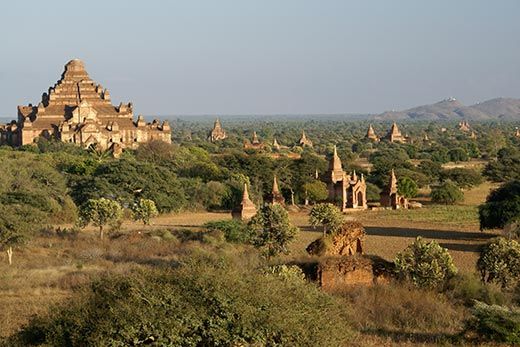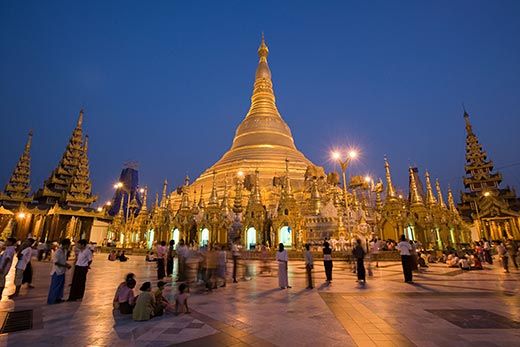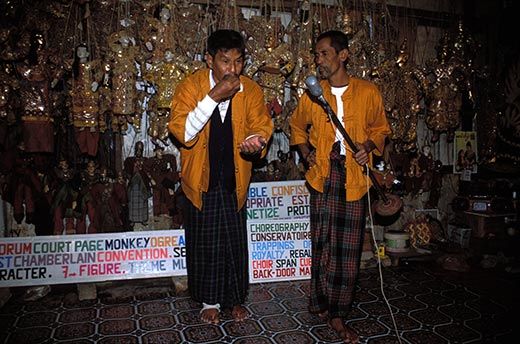Touring Myanmar
A practical guide of what to see in the southeast Asian country, from ancient temples to variety shows
/https://tf-cmsv2-smithsonianmag-media.s3.amazonaws.com/filer/Burma-Shwedagon-pagoda-631.jpg)
Rangoon
Rangoon, also known as Yangon, has changed dramatically from its circa-1980 days as an isolated socialist backwater. Today it is a modern if run-down city, with sushi bars, traffic jams, Internet cafes, and a thriving art-and-music scene. Hip-hop concerts occur throughout the year in both outdoor venues and night clubs, and at the city’s avant-garde galleries –the New Zero Art Studio on BoYar Nyunt Street in Dagon Township, the Lokanat Gallery and Inya Gallery - painters and video artists regularly test the junta’s censorship laws.
Rangoon also abounds with timeless pleasures, most of all Shwedagon Pagoda, a thirty-story gilded temple built more than a thousand years ago, that is believed to contain eight hairs of the Gautama Buddha. I’ve found the best time to visit Shwedagon is just before sunset, when the complex is packed with pilgrims, monks, and novitiates and the sharply angled light makes the golden spires that surround the pagoda seem as if they are ablaze. Afterward, I wandered the alleys in close proximity to the complex’s western gate, past curbside tea shops and market stalls selling everything from mangosteens and papayas to cheap Buddhist trinkets and soccer balls. The mingling aromas of sandalwood, chicken broth, garlic, and diesel fuel conjure up an exotic world. A long stroll through riverside Rangoon revealed a time-warped quarter of decaying British colonial tenements with laundry hanging from its filigreed balconies. My promenade ended with tea on the terrace of The Strand hotel, a century-old landmark by the river that has been thoroughly remodeled into one of the city’s swankiest establishments.
Pagan
Reachable by a one-hour flight from Rangoon on Air Pagan or Air Mandalay is Pagan, the eleventh-century imperial capital of King Anawrahta and the ccountry’s most popular tourist destination. Anawrahta, who is credited with bringing Theravada Buddism to Burma, and his successors built three thousand Buddhist temples across a flood plain on the east bank of the Irrawaddy River; the construction craze ended with the invasion of the Mongols around 1280 A.D. Some structures resemble stepped Mayan pyramids. Others are soaring limestone pagodas oddly akin to the grandiose palaces built by Joseph Stalin in Moscow in the 1930s. To visit them, I hired a rickety one-speed Chinese bicycle from the vendor in front of my luxurious resort, the Bagan Palace Hotel (owned by a crony of General Than Shwe, the leader of the military junta) and wandered with a friend for hours down dirt paths through groves of palm trees and thickets of grass, finding tucked-away stupas at every turn. (Two flat tires later, I realized why most tourists prefer to pay a driver to take them around the temples by horse cart.) After dawn on my second morning in Bagan, I climbed a crumbling exterior staircase to the top of a brick stupa two hundred feet above the plain, and gazed upon a mist-shrouded vista of ruins that extended for miles, savoring the silence.
Mandalay
From Bagan I flew south along the Irrawaddy River to Mandalay, the second largest city of Burma and the imperial capital before the third Anglo-Burmese war of 1885 placed the entire country in British hands. Made famous by Rudyard Kipling’s poem, “The Road to Mandalay,” the city is a bustling place of bicycle rickshaws, low-slow concrete-block houses, Buddhist temples and monasteries. It is also the site of the Mandalay Palace, home to Burma’s last King, which was destroyed by a fire after World War II and rebuilt by the junta using forced labor in the 1990s. The main reason for my visit, however, was to see the Moustache Brothers, a world-reknowned comedy-dance-vaudeville troupe that toured all over Burma until they ran afoul of Than Shwe and his fellow generals in the 1990s. Oldest member Par Par Lay and his cousin, Lu Maw, were imprisoned for five years at hard labor after a performance at Aung San Suu Kyi’s villa in 1997; then, during the 2007 Saffron Revolution, Par Par Lay served another prison term for raising money for protesting monks. Today the Moustache Brothers are confined to performing for foreign tourists in a garage-like space in front of their house on a 39th Street. Led by Par Par Lay’s younger sibling, Lu Zaw - a manic, fifty-seven-year old former bootlegger who peppers his English monologue with jokes about government corruption – they are a testament to the spirit of defiance that exists in tucked away corners of this long-suffering nation.


